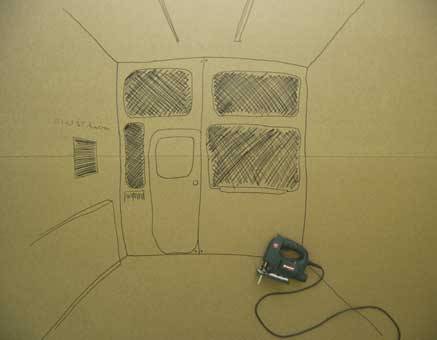Alex Winters
09 Sep - 14 Oct 2006
ALEX WINTERS
"140-degree "
Rotating something by 140° produces a very different picture. Instead of a more common 180° or 90° turn, it is something unusual in between. In his first solo exhibition at Galerie Fons Welters, Alex Winters presents the space at Bloemstraat 140 from this 140° vantage point, which seems to rotate everyday spaces and objects out of their invisibility.
At first sight the gallery seems little changed. It is not until unusual corners, narrow doors and high thresholds impede one's normal progress that it becomes clear that Alex Winter has added subtle obstacles and altered the space. Here and there are screens displaying video presentations, and in other places walls have been erected. How visitors are supposed to navigate the gallery and where they are supposed to sit to look at the work is purposefully left open.
Alex Winters translates his personal view of the gallery space and of space in general into different media, encouraging viewers to really take in what they see. For instance, part of the space is screened off by a partition on which a two-dimensional drawing of that space is displayed. The result is a spatial paradox - what is in the space is the space itself. At the same time we are delivered into the artist's own view of that space and his recollection of it, which was no longer visible while he was drawing. Three-dimensionality captured on a flat surface prompts the drawing of comparisons and heightens viewers' consciousness of their own experience as opposed to the artist's. In the gallery's rear room is a video showing the surroundings of a place that is significant to the artist. The context of a space is captured in the space itself. In the same film, we see the artist trying to convey this whole area on a flat surface: partly by drawing over the images displayed and partly by using his own experience of the area.
The interplay between the reality of the space, the fictitious two-dimensional and three-dimensional presentations of this space, and the viewer in between, serves as a stimulus to truly experience the space. The inconsistencies and changes of perspective in the artist's drawing are essential; he does not simply make a drawn copy. The aim is not to hold up a mirror to reality but to convey a personal experience of this reality. It is an attempt to capture an experience, similar in this sense to Cézanne's strivings in his numerous images of Mont Sainte-Victoire. Alex Winters goes a step further, and sets out to make his viewers more conscious of their own experience. Sometimes we have to turn our head a little to really see what is there.
[Laura van Grinsven]
© Alex Winters
"140-degree "
Rotating something by 140° produces a very different picture. Instead of a more common 180° or 90° turn, it is something unusual in between. In his first solo exhibition at Galerie Fons Welters, Alex Winters presents the space at Bloemstraat 140 from this 140° vantage point, which seems to rotate everyday spaces and objects out of their invisibility.
At first sight the gallery seems little changed. It is not until unusual corners, narrow doors and high thresholds impede one's normal progress that it becomes clear that Alex Winter has added subtle obstacles and altered the space. Here and there are screens displaying video presentations, and in other places walls have been erected. How visitors are supposed to navigate the gallery and where they are supposed to sit to look at the work is purposefully left open.
Alex Winters translates his personal view of the gallery space and of space in general into different media, encouraging viewers to really take in what they see. For instance, part of the space is screened off by a partition on which a two-dimensional drawing of that space is displayed. The result is a spatial paradox - what is in the space is the space itself. At the same time we are delivered into the artist's own view of that space and his recollection of it, which was no longer visible while he was drawing. Three-dimensionality captured on a flat surface prompts the drawing of comparisons and heightens viewers' consciousness of their own experience as opposed to the artist's. In the gallery's rear room is a video showing the surroundings of a place that is significant to the artist. The context of a space is captured in the space itself. In the same film, we see the artist trying to convey this whole area on a flat surface: partly by drawing over the images displayed and partly by using his own experience of the area.
The interplay between the reality of the space, the fictitious two-dimensional and three-dimensional presentations of this space, and the viewer in between, serves as a stimulus to truly experience the space. The inconsistencies and changes of perspective in the artist's drawing are essential; he does not simply make a drawn copy. The aim is not to hold up a mirror to reality but to convey a personal experience of this reality. It is an attempt to capture an experience, similar in this sense to Cézanne's strivings in his numerous images of Mont Sainte-Victoire. Alex Winters goes a step further, and sets out to make his viewers more conscious of their own experience. Sometimes we have to turn our head a little to really see what is there.
[Laura van Grinsven]
© Alex Winters

